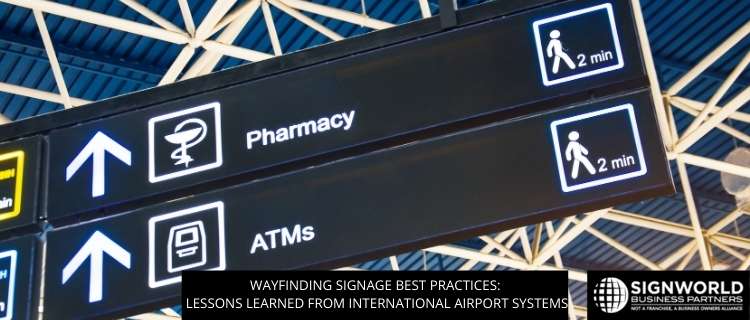Today’s post draws from research by the Legible Wayfinding journal to explain how airport wayfinding best practices can be applied to improve in-store sign system performance. Read on or call 888-765-7446 to find a Signworld wayfinding expert near you.
[sc_fs_faq html=”true” headline=”h2″ img=”” question=”Why Study Airport Wayfinding Systems? ” img_alt=”” css_class=”ct-faq”] Chances are you’re trying to run a business, not an airport, so why look at these international transit hubs to inform your in-store setups? [/sc_fs_faq]
“Airports are complex spaces that exist primarily for the purpose of allowing significant numbers of people to fly from, and into, a specific location,” writes Symonds (2017, p. 60). “In these spaces, wayfinding is an important process, given that people need to be moved in a time-effective and safe manner.”
Given the challenge and essentiality of wayfinding systems in this environment, airports make for perfect case studies, and great sources of wayfinding best practices. By implementing some of the theories used to achieve airport wayfinding success, your business facilitates improved customer experiences, which equates to repeat customers, brand-loyalty boosts, and greater sales.
Wayfinding Signage Lessons Learned From International Airport Systems
How To Successfully Include More Than One Language On Wayfinding Signage
Multilingual signage is essential for optimizing wayfinding outcomes (and thus, sales) in many parts of the country. For instance, according to research on the languages of the United States, as much as 13.5% of the US population are primarily Spanish-speaking, while another 3.7% favors Indo-European languages. These numbers run even higher in certain parts of the country, and many business owners use multilingual signage in these areas.
Multilingual signage can be confusing, though, and it can quickly appear cluttered when two identical messages are displayed.
To address this problem, airport wayfinding system researchers recommend the following:
- Color-coding—When displayed the same message in two languages, color coding is a great way to help viewers distinguish between the two at-a-glance. Consistency is key: as viewers move through the space, they’ll quickly learn which colors to pay attention to, so they can make faster decisions on-the-go (e.g. English speakers only read the red text, while Spanish speakers read blue text).
- Universal symbols—Another way airport wayfinding system designers worked around this problem was by including “icons that are globally recognized” instead of two languages. Business owners might use a cash register icon to indicate check-out areas, or toilet icons to indicate restrooms, rather than spelling each word out in each language.
How To Keep Multiple Wayfinding Signs From Competing With One Another
Wayfinding systems need to work together with advertising signage, not compete against it. Airport businesses (e.g. restaurants, souvenir shops) need to make a profit, which means their signage needs to be seen, but it cannot detract from the airport’s wayfinding functionality. The same is true of almost any business.
To prevent wayfinding sign systems from competing with your advertising, Symonds (2017) recommends creating specific areas for each sign type. For example, point-of-sale signage should not be placed right alongside directional signage. Instead, clear grouped areas for signage should be planned, and sight-lines for directional signage must be maintained. One popular way to do this is by assigning different sign types dedicated vertical space, so that wayfinding signage hangs from the ceiling while in-store promotions engage viewers at eye-level.
Find Wayfinding Sign Experts Near You
We’ve hardly scratched the surface of wayfinding theory in this brief article, but rest assured every Signworld partner is highly trained in signage system best practices. If you want to work with a true wayfinding expert, contact the Signworld business alliance and find a partner in your community.
Call 888-765-7446 or visit the Signworld business alliance website to access more than 330+ businesses across the country.
References
Symonds, P. (2017). Wayfinding signage considerations in international airports. Legible Wayfinding: Navigating Interior and Exterior Landscapes, 1(2): 60-91. Retrieved from https://repository.cardiffmet.ac.uk/bitstream/handle/10369/8801/Journal-wayfinding.pdf?sequence=1&isAllowed=y




